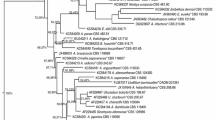Abstract
There is an increasing demand for novel antibiotics that are highly effective, but simultaneously reveal minimal side effects. Currently, major sources of antibiotics are found among bacterial genus Streptomyces and among fungal genera Penicillium and Aspergillus. Chaetomium represents the largest genus of the family Chaetomiaceae actually containing more than 100 described species. This rather complex genus has been reported as a rich source of secondary metabolite products with important biological activities, such as enzyme-inhibitory, antitumour, cytotoxic, antimalarial and also antibiotic effects. One of them, chaetomin, a part of Chaetomium cochliodes antimicrobial equipment was discovered already in the early period of antibiotics discovery, but later not investigated in sufficient detail. In this contribution we have studied Chaetomium cochliodes Palliser CCM F-232 for its possible antibacterial properties. For comparisons, a closely related fungus Chaetomium globosum was also employed. Antibacterial properties of Chaetomium sp. were tested on natural bacterial isolates of Staphylococcus aureus and Bacillus subtilis. We performed several antimicrobial tests with a correlating output. Antibacterial effects of these filamentous fungi were demonstrated either by the presence of susceptibility zones on solid agar media in the case of S. aureus or by growth inhibition in liquid broth in the case of Staphylococcus aureus and Bacillus subtilis.
Similar content being viewed by others
Abbreviations
- A600:
-
absorbance measured at a wavelength of 600 nm
- CD agar or broth:
-
Czapek Dox agar or broth with 1% corn extract powder
- IM:
-
intermediate
- LB:
-
Luria-Bertani
- MPG:
-
agar or broth, malt peptone glucose agar or broth
- PME:
-
agar or broth, potato malt extract agar or broth with stripes of filter paper
- RT:
-
room temperature 0.45 μmCco/Cgl MPG/PME/CD, filtrates through 0.45 μm membrane obtained from C. cochliodes or C. globosum cultivated in MPG, PME or CD broth
References
Bai H., Wu L., Yang T. & Li G. 2015. Isolation and identification of secondary metabolites from fungus Chaetomium gracile and their antimicrobial activities. Chin. J. Appl. Environ. Biol. 21: 274–278.
Berdy J. 2012. Thoughts and facts about antibiotics: where we are now and where we are heading. J. Antibiot. 65: 385–395.
Deng Y., Hua Z., Zhao Z. & Chen J. 2008. Effect of nitrogen sources on catalase production by Bacillus subtilis WSHDZ- 01. Chin. J. Appl. Environ. Biol. 14: 544–547.
de Siqueira V.M., de Araujo R.J.M. & Souza-Motta C.M. 2011. Endophytic fungi from the medicinal plant Lippia sidoides Cham. and their antimicrobial activity. Symbiosis 53: 89–95.
Frisvad J. C. 1986. Taxonomic approaches to mycotoxin identification, pp. 415–457. In: Cole R.J. (ed.) Modern Methods in the Analysis and Structural Elucidation of Mycotoxins. Academic Press, Inc., New York.
Garcia-Kirchner O., Segura-Granados M., Robledo-Bautista I. & Duran-Paramo E. 2000. Screening of potential antibiotic action of cellulolytic fungi. Appl. Biochem. Biotechnol. 84-86 769–778.
Geiger W.B., Conn J.E. & Waksman S.A. 1944. Chaetomin, a new antibiotic substance produced by Chaetomium cochliodes. II. Isolation and concentration. J. Bacteriol. 48: 531–536.
Hutchinson M.I., Powell A.J., Tsang A., O’Toole N., Berka R.M., Barry K., Grigoriev I.V. & Natvig D.O. 2016. Genetics of mating in members of the Chaetomiaceae as revealed by experimental and genomic characterization of reproduction in Myceliophthora heterothallica. Fungal Genet. Biol. 86: 9–19.
Hwang E.I., Yun B.S., Kim Y.K., Kwon B.M., Kim H.G., Lee H.B. & Kim S U. 2000. Chaetoatrosin A, a novel chitin synthase II inhibitor produced by Chaetomium atrobrunneum F449. J. Antibiot. 53: 248–255.
Kobayashi M., Yoshimura S., Kinoshita T., Hashimoto M., Hashimoto S., Takase S., Fujie A., Hino M. & Hori Y. 2005. FR207944, an antifungal antibiotic from Chaetomium sp. no. 217 II. Isolation and structure elucidation. Biosci. Biotechnol. Biochem. 69: 1029–1032.
Kogel K.H., Franken P. & Hückelhoven R. 2006. Endophyte or parasite–what decides? Curr. Opin. Plant Biol. 9: 358–363.
Lam K.S. 2007. New aspects of natural products in drug discovery. Trends Microbiol. 15: 279–289.
Nielsen K.F., Gravesen S., Nielsen P.A., Andersen B., Thrane U. & Frisvad J.C. 1999. Production of mycotoxins on artificially and naturally infested building materials. Mycopathol. 145: 43–56.
Oh H., Swenson D.C. & Gloer J.B. 1998. Chaetochalasin A: a new bioactive metabolite from Chaetomium brasiliense. Tetrahedron Lett. 39: 7633–7636.
Pereira E., Santos A., Reis F., Tavares R.M., Baptista P., Lino-Neto T. & Almeida-Aguiar C. 2013. A new effective assay to detect antimicrobial activity of filamentous fungi. Microbiol. Res. 168: 1–5.
Pettit R.K. 2011. Small−molecule elicitation of microbial secondary metabolites. Microb. Biotechnol. 4: 471–478.
Pitt J.I. & Samson R.A. 1990. Approaches to Penicillium and Aspergillus systematics. Stud. Mycol. 32: 77–90.
Piyasena K.G.N.P., Wickramarachchi W.A.R.T., Savitri Kumar N., Jayasinghe L. & Fujimoto Y. 2015. Two phytotoxic azaphilone derivatives from Chaetomium globosum, a fungal endophyte isolated from Amaranthus viridis leaves. Mycology 6: 158–160.
Provost N.B., Shi C., She Y.M., Cyr T.D. & Miller J.D. 2013. Characterization of an antigenic chitosanase from the cellulolytic fungus Chaetomium globosum. Med. Mycol. 51: 290–299.
Radic N. & Srukelj B. 2012. Endophytic fungi–the treasure chest of antibacterial substances. Phytomedicine 19: 1270–1284.
Smith K.M., Gautschi J.T. & Freitag M. 2014. Decoding the cryptic genomes of fungi: the promiseof novel antibiotics. Future Microbiol. 9: 265–268.
Song J.H. 2008. What’s new on the antimicrobial horizon? Int. J. Antimicrob. Agents 32: S207–S213.
Theuretzbacher U., Van Bambeke F., Cantón R., Giske C.G., Mouton J.W., Nation R.L., Paul M., Turnidge J.D. & Kahlmeter G. 2015. Reviving old antibiotics. J. Antimicrob. Chemother. 70: 2177–2181.
Zhang Q., Li H.Q., Zong S.C., Gao J.M. & Zhang A.L. 2012. Chemical and bioactive diversities of the genus Chaetomium secondary metabolites. Mini Rev. Med. Chem. 12: 127–148.
Acknowledgements
Our research was supported by the Slovak Research and Development Agency with grant APVV-14-0375 and by the Slovak Grant Agency VEGA with grant 2/0021/14.
Author information
Authors and Affiliations
Corresponding author
Rights and permissions
About this article
Cite this article
Chovanová, K., Zámocký, M. Detection of the antibacterial effect of Chaetomium cochliodes Palliser CCM F-232 based on agar plugs and unprocessed fungal substances from cultivation media. Biologia 71, 1204–1211 (2016). https://doi.org/10.1515/biolog-2016-0153
Received:
Accepted:
Published:
Issue Date:
DOI: https://doi.org/10.1515/biolog-2016-0153




